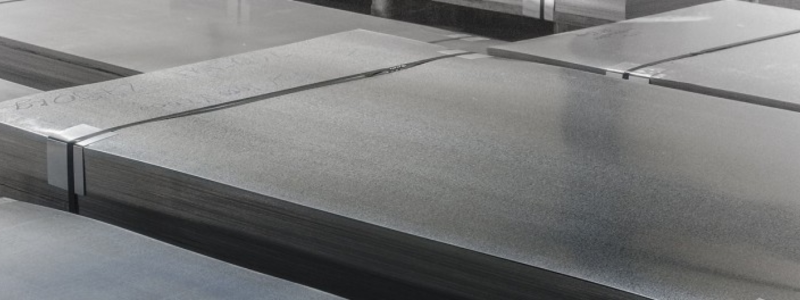Hastelloy C-276 Sheets & Plates
Hastelloy C-276 is a nickel-molybdenum-chromium alloy renowned for its outstanding corrosion resistance in a wide range of aggressive chemical environments. Plates and sheets made from Hastelloy C-276 are integral components in various industries.

The chemical compositions of Nickel, Molybdenum, and Chromium are used to produce Hastelloy C-276 Sheets and plates. Adding tungsten to it can increase the corrosion resistance of the product. The nickel and molybdenum component of ASTM B575 Hastelloy C-276 Sheets aids in their resistance to pitting and crevice corrosion in reducing conditions.
These Hastelloy C276 Plates are also resistant to the production of grain boundary precipitates in the welding thermally – impacted area zone, making them suitable for most chemical operations in their as-welded state. In addition, our Hastelloy C276 Sheet and Plates have great resistance to oxidizing ions due to their properties. Finally, our Hastelloy C276 Sheets are also resistant to saltwater corrosion, particularly in crevice circumstances, which cause an attack on other regularly utilized metals.
We try to provide Hastelloy UNS N10276 sheets that are ideal for various sectors and meet our clients’ needs. We manufacture ASTM B575 Hastelloy C-276 plates in a variety of sizes and specifications. We also accept special requirements from clients and manufacture Hastelloy C-276 sheets by their specifications.
Our ASTM B575 Hastelloy C-276 Sheets and Plates have a wide range of applications and may be found in various industries. For example, Hastelloy C-276 plates are used to produce pharmaceuticals and food manufacturing equipment. Hastelloy UNS N10276 sheets are also used in pulp and paper manufacturing, and acidic oil wells Hastelloy C-276 plates are also used to make pollution control stacks lining, ducting, and damper.
Specifications
- Hastelloy C-276 plates are extensively used in industries where resistance to corrosion is of paramount importance, such as chemical processing, petrochemical, and pollution control equipment.
- They offer exceptional resistance to a variety of corrosive substances, including sulfuric acid, hydrochloric acid, and chlorine.
- Hastelloy C-276 plates are available in different thicknesses and dimensions to meet specific project requirements.
- Hastelloy C-276 sheets are commonly used in applications requiring a flat, thin material with excellent corrosion resistance.
- They are suitable for fabricating various components, including vessels, tanks, and heat exchangers, in aggressive chemical environments.
- Hastelloy C-276 sheets come in various sizes to accommodate specific project needs.
- Thickness –1mm to 25mm
- Width – standard – 1219mm, 1250mm, 1500mm, 2000mm wide
- Length – 2500, 3000, 6000mm long
Hastelloy C-276 Plates:
Hastelloy C-276 Sheets:
Hastelloy C-276’s remarkable resistance to a broad spectrum of corrosive media, combined with its ability to maintain mechanical properties in high-temperature and high-stress conditions, makes it an ideal choice for applications where corrosion is a major concern. When selecting Hastelloy C-276 plates and sheets for a specific application, it’s important to consider the corrosive environment and the required performance characteristics to ensure the longevity and effectiveness of the materials in that particular setting.
size range
Material Certification and Traceability
At Satyam Overseas, we prioritize Material Certification and Traceability. Our materials, meeting ASTM and ASME standards, come with 3.1 Mill Test Certificates as a guarantee of compliance. Additionally, upon request, we provide 3.2 Mill Test Certificates for added assurance. Every material is clearly marked and accompanied by a corresponding certificate, meticulously linking markings to certification. This meticulous approach ensures complete accountability and unwavering reliability throughout our supply chain.
Chemical Composition
| Grade | C | Mn | Si | S | Co | Ni | Cr | Fe | Mo | P |
|---|---|---|---|---|---|---|---|---|---|---|
| Hastelloy C276 | 0.010 max | 1.00 max | 0.08 max | 0.03 max | 2.50 max | 2.50 max | 14.50 – 16.50 | 4.00 – 7.00 | 15.00 – 17.00 | 0.04 max |
Physical Composition
| Element | Density | Melting Point | Tensile Strength | Yield Strength (0.2%offset) | Elongation |
|---|---|---|---|---|---|
| Hastelloy C276 | 8.89 g/cm3 | 1370 °C (2500 °F) | Psi – 1,15,000, MPa – 790 | Psi – 1,15,000, MPa – 790 | 40% |
Designations & Standards
| Forms | ASTM | ASME | DIN |
|---|---|---|---|
| Sheet, plate | B575 | SB 575 | 17744 |
Differences between Monel and Hastelloy
Monel and Hastelloy are two different types of nickel-copper alloys. Monel is more corrosion resistant, but it is less heat-conductive. It also has a lower melting point. This makes it perfect for high-temperature uses such as stove tops and gas pipes. But if you want a material with a higher melting point, you would be better off choosing Hastelloy because it can withstand very high temperatures without losing any strength or corrosion resistance. Monel is a nickel-copper alloy that resists corrosion in acidic environments. It can be used in piping, valves, and other fluid transfer components.
Monel parts are also good for use in high-temperature applications. Hastelloy is an alloy of nickel, chromium, and molybdenum. It provides the right mix of both tensile strength and corrosion resistance for most industrial applications. Monel is a family of iron-nickel alloys containing nickel and copper, called cupronickel. Monel metal is nonmagnetic and resistant to corrosion in seawater. Hastelloy is a family of nickel-based superalloys, with a percentage of cobalt, titanium, iron, and molybdenum making up the composition. Hastelloy has a much higher nickel content than Monel. Monel is a nickel-copper alloy, and Hastelloy is a series of alloys containing nickel and several other metals. Monel has a low voltage coefficient and is resistant to most corrosive environments. Whereas Hastelloy is designed for applications in high-temperature, oxidizing environments.
Differences between Inconel and Hastelloy
Inconel and Hastelloy are both nickel-chromium-molybdenum-based alloys. They are all corrosion-resistant and extremely strong metals. Hastelloy has greater molybdenum content than Inconel, although Inconel has a higher chromium concentration. This sets them apart in terms of corrosion resistance in different situations.